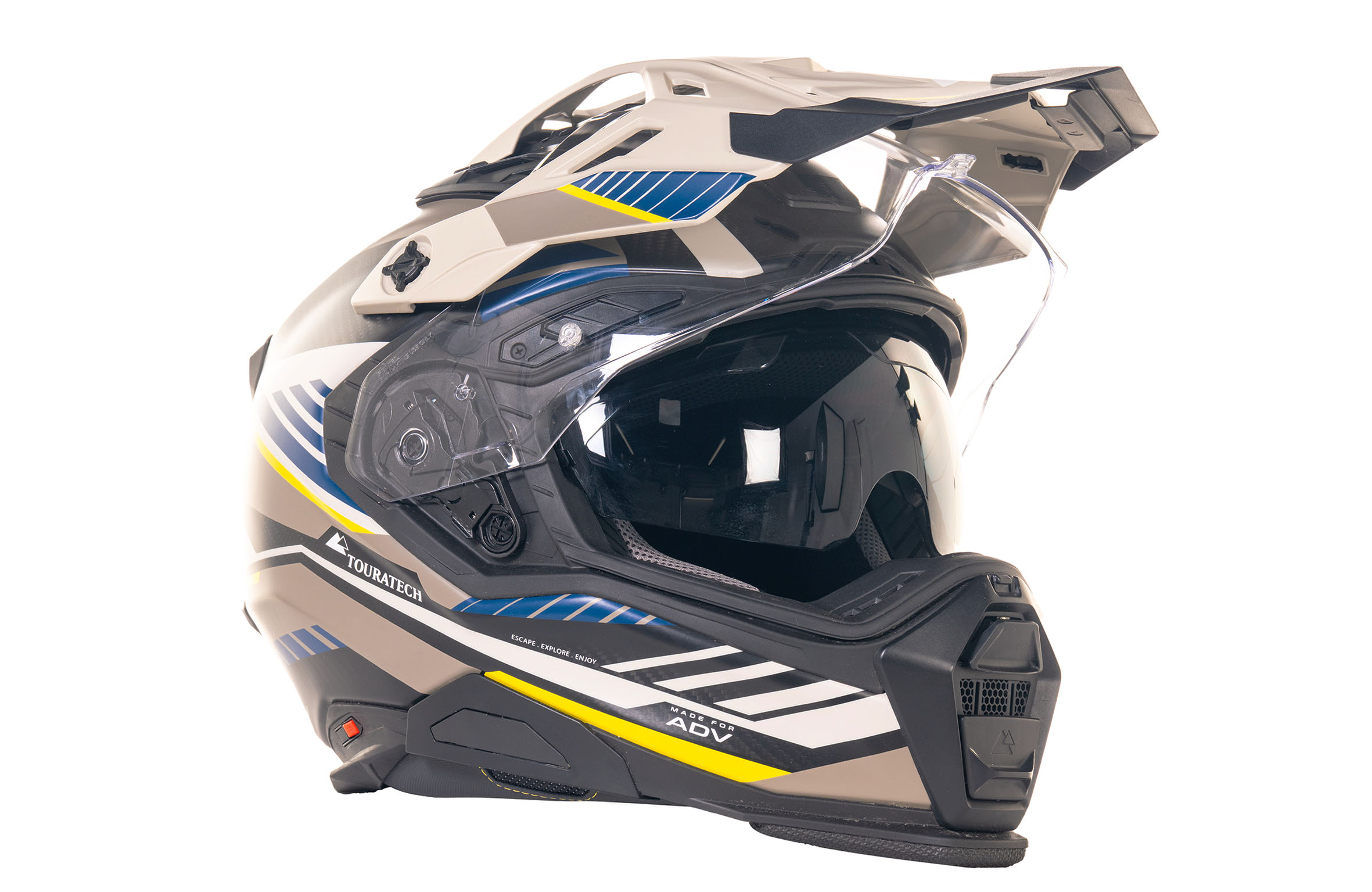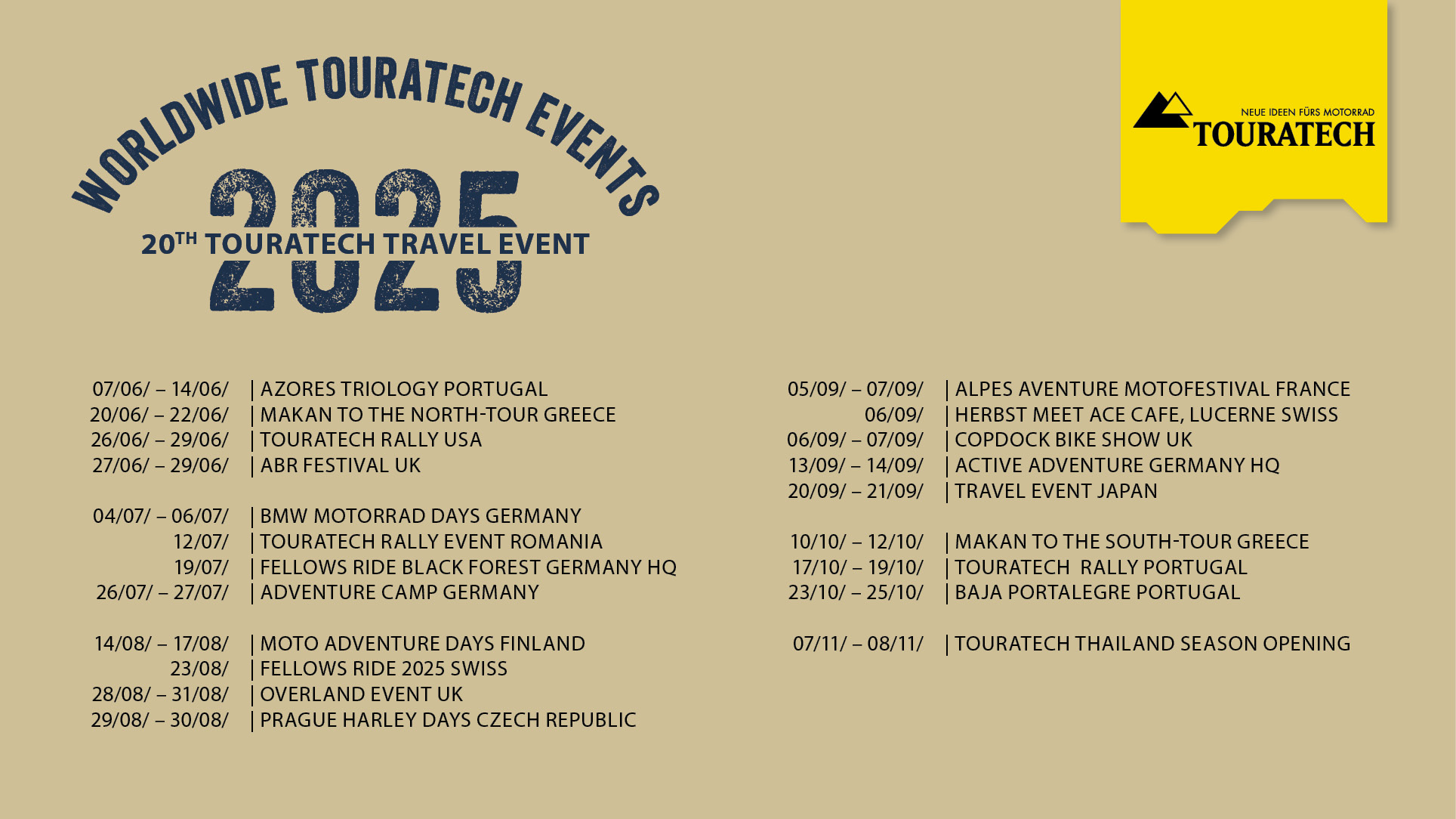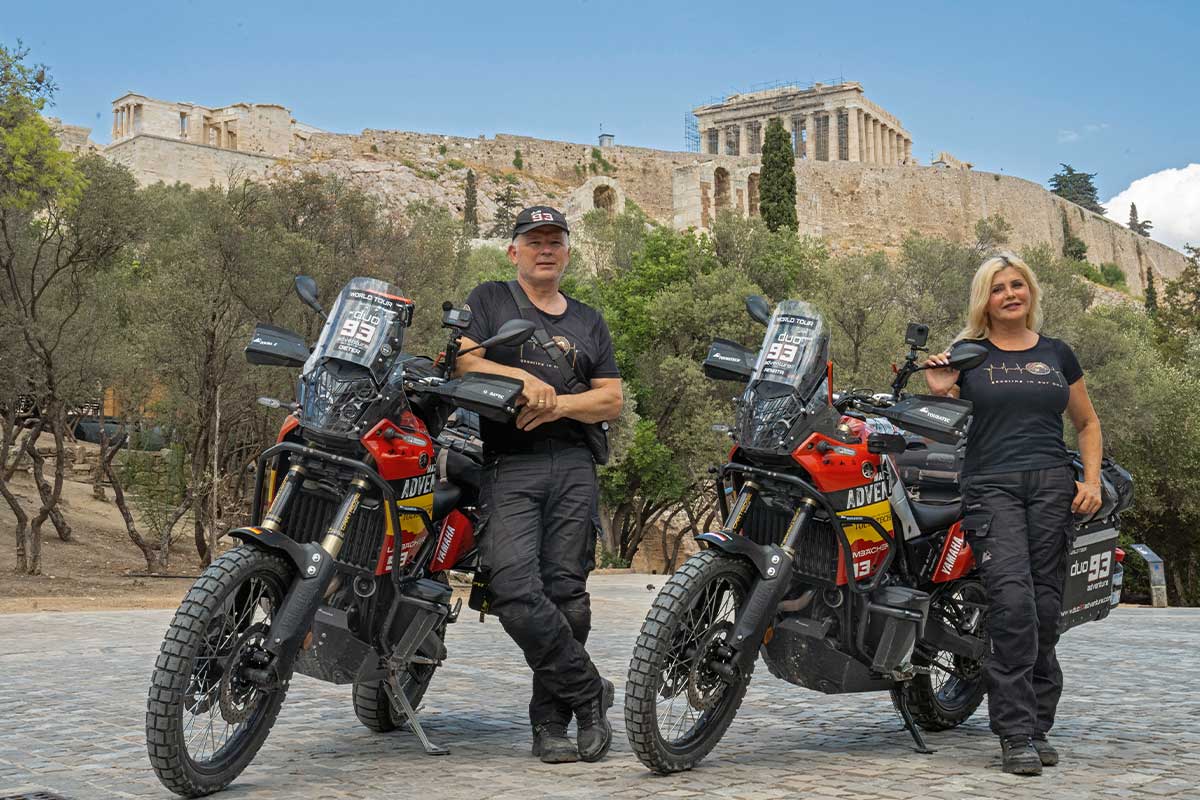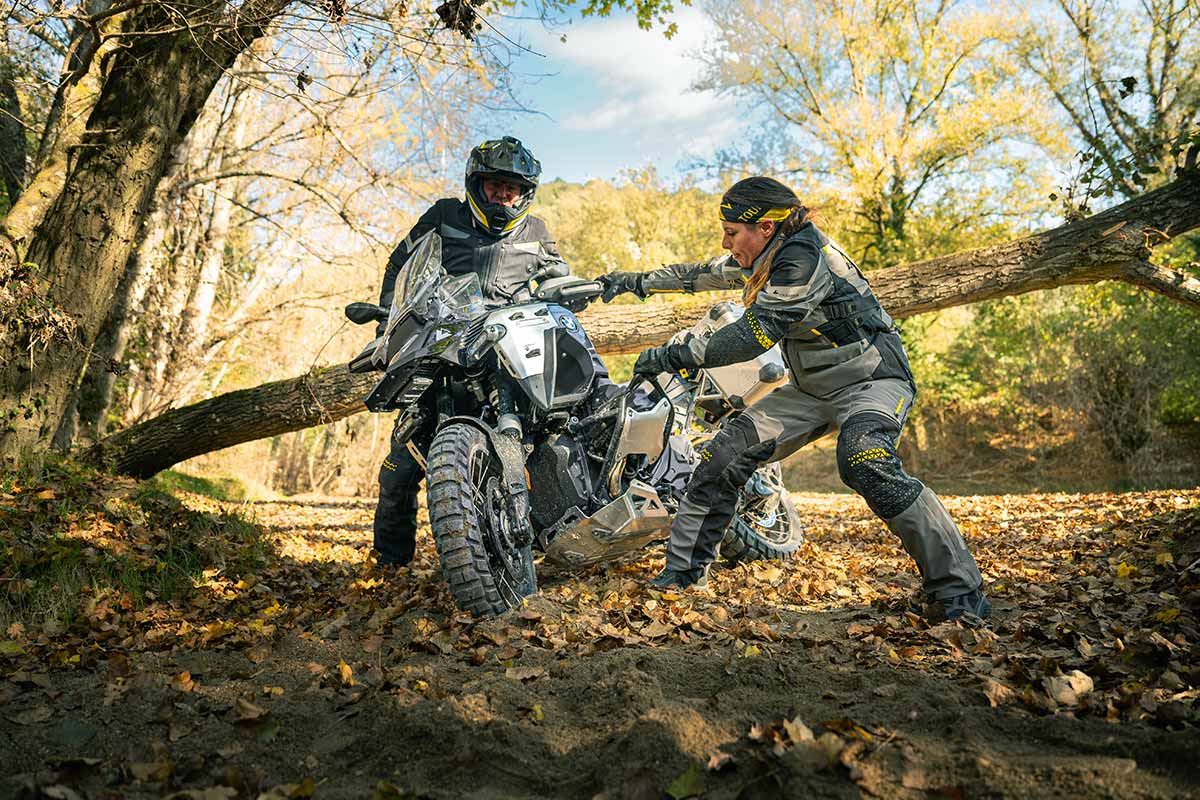TRAVEL | Andreas Hülsmann – 45 Jahre out and about: Travel times

Andreas Hülsmann has been travelling around the world on motorbikes for 45 years. During this time, a lot has changed for travellers – especially when it comes to equipment. Motorbike adventurer Hülsmann has been relying on Touratech products for 25 years.
Text and Photos: Andreas Hülsmann
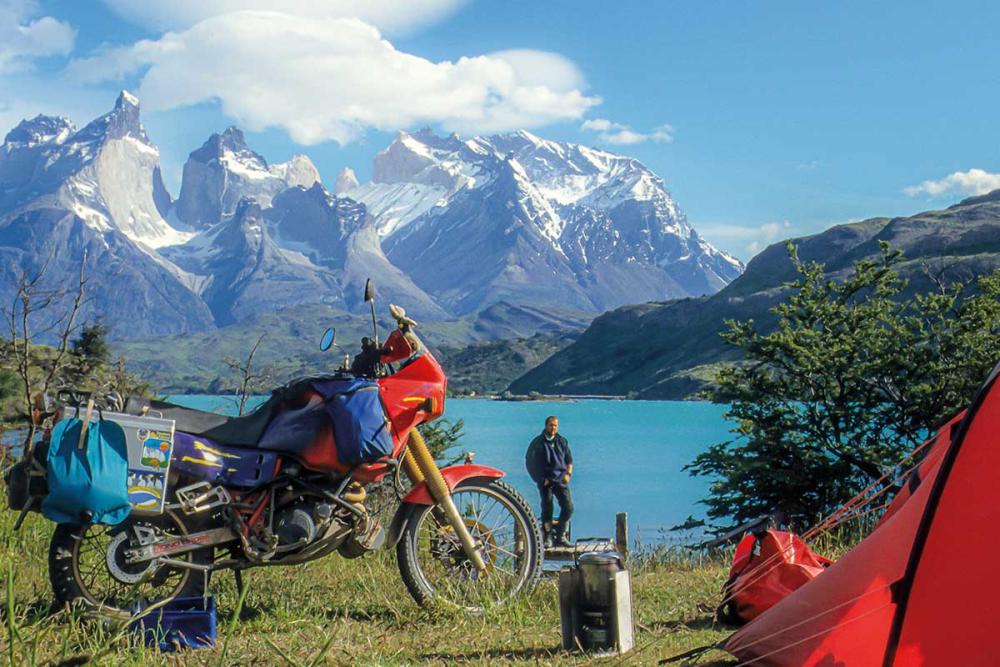
Travelling the world on a motorbike is still my passion today. It started early on, when I had just got my "Einser" motorcycle driver’s license, and my head was already spinning with travel plans. My thoughts weren't about mere weeks, I wanted to be travelling for months. I never thought about the consequences or what would I would do after such a tour. The urge to storm out into the world on my motorbike was simply there. The "travel bug" had infected me, and to this day there is no cure for it. The fact that I was ultimately able to turn this combination of wanderlust and motorcycling into a career was, of course, a lucky coincidence.
But at first it didn't look like a life of travelling. I had completed an apprenticeship, followed by a vocational diploma and university studies. But this travel bug kept causing problems, like on my very first trip. I was travelling to Scotland with a friend at the end of March. A time of year which, as we tremblingly learnt, is not really suitable for motorbike tours in this region. But our wanderlust was so great that we arbitrarily decided to bring forward the upcoming Easter holidays by a few days. That was 1980, a time when an oversized "elephant boy" dominated the petrol tank of my Suzuki GS 400, the suitcases were made of cardboard and artificial leather and the rack pack was a simple bin bag.

My first travelling experiences were almost 45 years ago. We set off without any knowledge of what to expect. By today's standards, our equipment was a hodgepodge of things that didn't even deserve to be called "basic". My towelling sleeping bag had a comfort zone designed for tropical temperatures. Lined with cotton wool, it was no match for the frosty nights in Scotland. A lot has changed in every respect in the four and a half decades since then. Carburettors and contact ignition were the technical standard in 1980, ABS or even riding modes were still unknown in the motorbike sector. Navigation was done with paper, and you had the choice between leather or waxed cotton for the rider's suit. Nevertheless, these early journeys were experiences that I wouldn't want to have missed.
But the possibilities offered by motorbikes, accessories and rider equipment today are simply of a different dimension, which also lowers the inhibition threshold for simply setting off. Since I travelled to Australia in the mid-1990s, at least one new feature has been added on almost every trip. First there were the waterproof luggage rolls, which you could rely on to keep your clothes dry even in constant rain. Then there was the Garmin III plus, a sat nav with a tiny monochrome screen. The map material for this device was more than poor, but the ability to navigate to a coordinate by following an arrow on the screen was a real innovation at the time. And the fact that Touratech had the right mount in its repertoire made this Garmin a permanent fixture on my tours. The next big innovation was the triumph of digital photography. In addition, laptops were slowly becoming a handy format and communication from the road via satellite was becoming affordable. While we were only able to send small texts from Australia to Germany via space on the Canning Stock Route in 2004, two years later we were able to send small pictures on the first "Course-East Tour". For the first time, it was also possible to follow our journey in "real time". A satellite tracker the size of a cereal bowl was attached to my wife Claudia's 1150 GS, which sent our location to the world every four hours.

I have followed the urge to travel eastward several times. And time and again I had the opportunity to take new developments and prototypes from Touratech with me on my journey. This includes the additional fuel tank for the BMW F 800 GS. Having more fuel on board can do no harm in the vastness of the Mongolian steppe or in the high altitudes of the Pamir. There were a number of test series products on tour, whereby even old-fashioned accessories had to be put to the test again and again. This was also the case on the desert journey through Western Australia. We packed almost 40 kilograms into our ZEGA cases (each!) and drove our motorbikes over the gruelling Canning Stock Route.
After almost 50 years of motorcycling, I have almost a million kilometres behind me. I've written around 500 reports on and about travelling, and there are around 80,000 diashows in my archive, while my image editing program lets me know that almost 150,000 digital images have accumulated on various hard drives. There are certainly a lot of pictures among them that are not worth seeing, but I find it difficult to delete even the less successful photos, because every picture somehow has a memory attached to it.
AUSTRALIA I CANNING STOCK ROUTE: THE 1,000-DUNE SEA
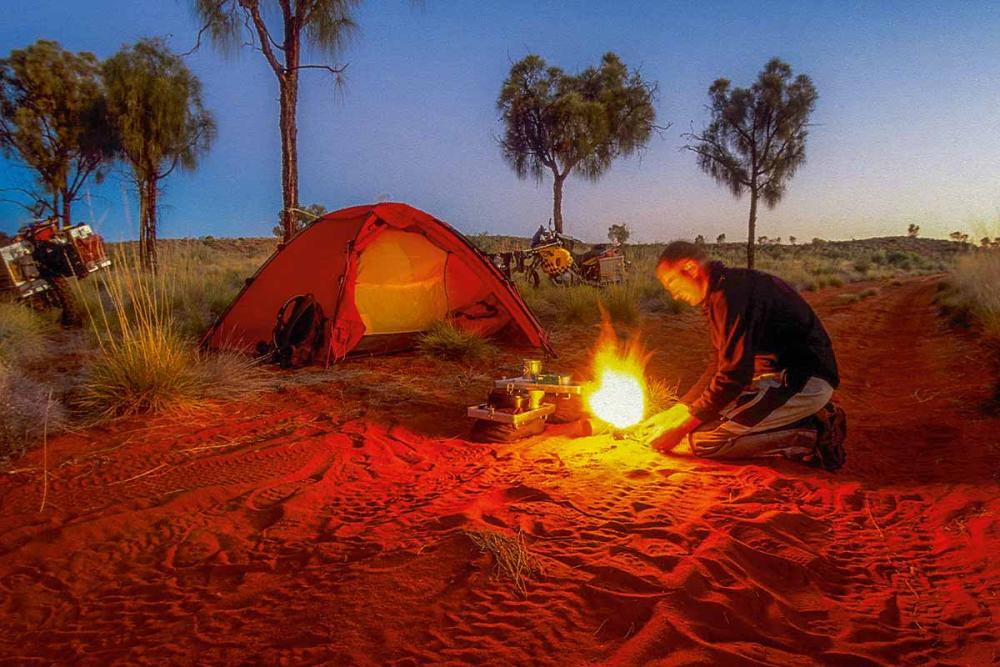
The dense vegetation requires us to camp on the track.
The Canning Stock Route, abbreviated CSR by insiders, stands for great adventure in Australia. The 2,000-kilometre-long former cattle trail, which was created at the beginning of the 20th century, leads through three deserts. The route, which 120 years ago was used to drive cattle from the north of Western Australia to the goldfields around Kalgoorlie, is now an badge of honour for every offroader "down under". There are more than 1,000 sand dunes to conquer. What's more, there are only two places to refuel on the stretch of road from Wiluna in the south to Halls Creek in the tropical north. A 200-litre petrol drum is waiting at Well 23, which travellers have to pre-order from the Capricorn Roadhouse around two months in advance. This is transported by lorry more than 600 kilometres into the desert. The second petrol station is in the Aboriginal community of Kunawarritji.
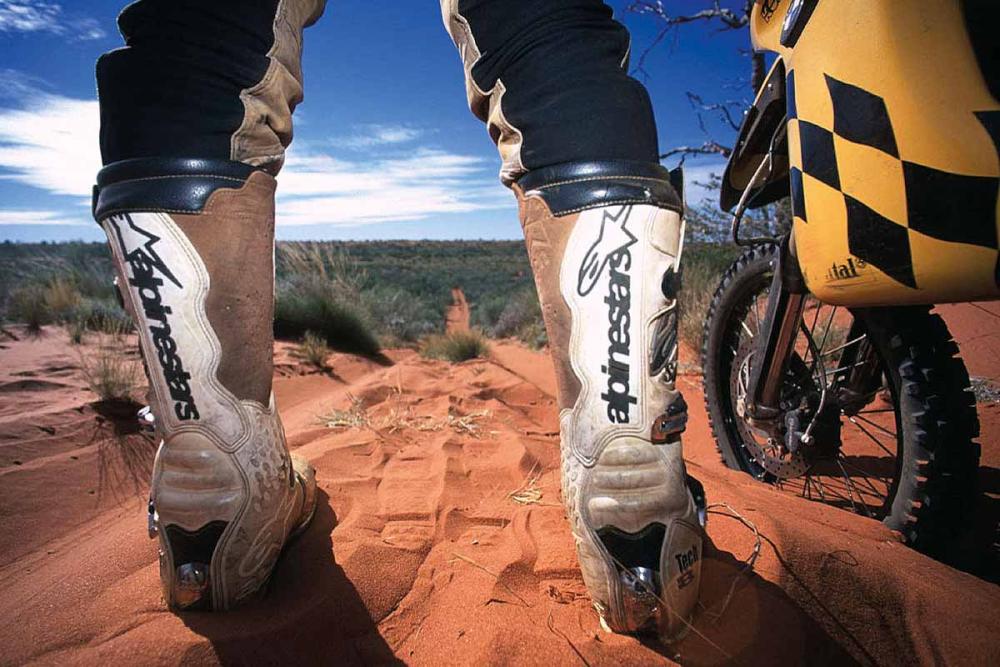
Endless: The view over the Great Sandy Desert expands the horizon.

Greenery: The deserts in Western Australia are densely overgrown.
My friend Jörg Becker (†) and I were travelling with two TT39s. The single-cylinder, built by Touratech on the basis of a BMW F 650 GS, had a special feature that was indispensable for this trip into solitude - a tank capacity of 39 litres and thus a range of 700 kilometres. The TT39 also had a luggage system, WP suspension and a swing arm with 18-inch rims. Additional fuel was stored under each case in a 12-litre plastic canister, which meant that each single had a fuel supply of 63 litres. 25 litres of water, provisions for a fortnight, tools, cameras and clothes brought the weight of the TT39 to around 340 kilograms. A massive mass that had to be moved through the loose sand. We spent almost three weeks travelling along the old cattle track and met fewer than two dozen people. The Canning Stock Route is a good place for anyone who wants to be truly alone.
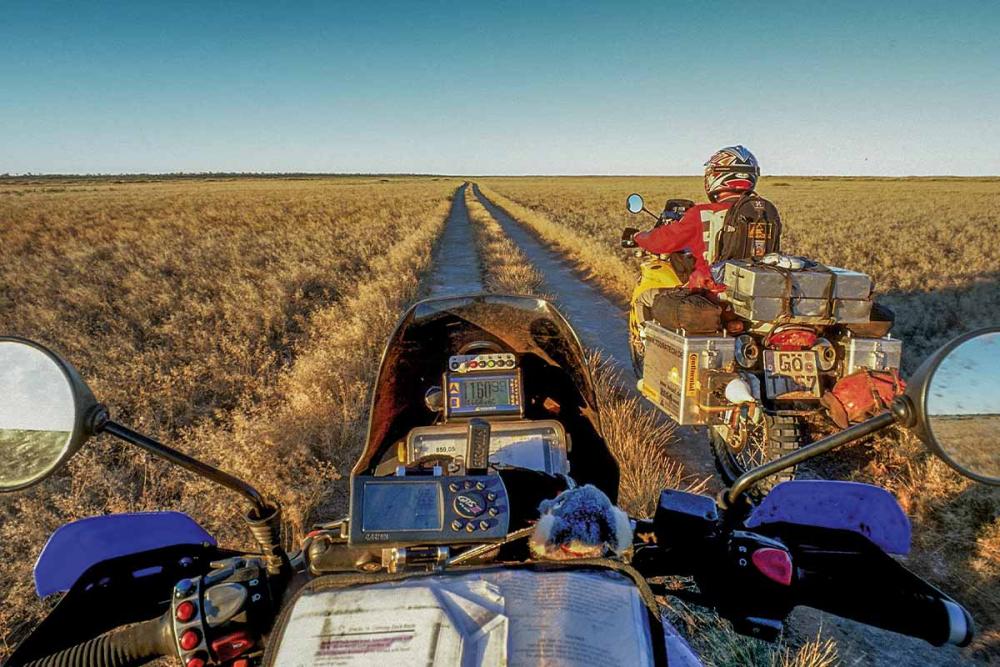
Hard: Lake Tobin provides a few kilometres of solid ground.
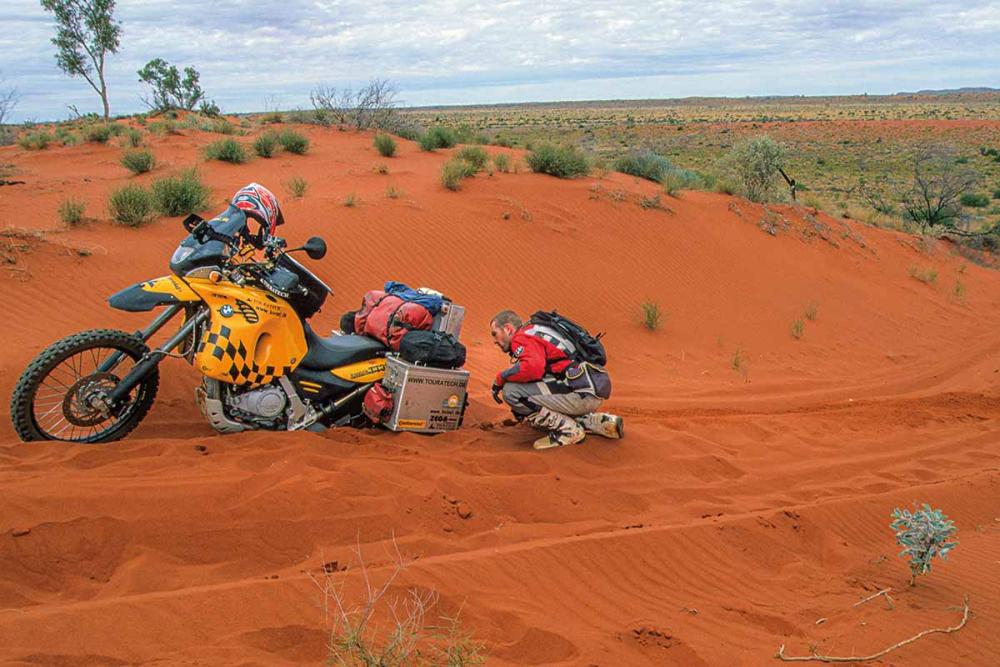
Soft: Digging out the BMWs in the dune sand was part of everyday life.
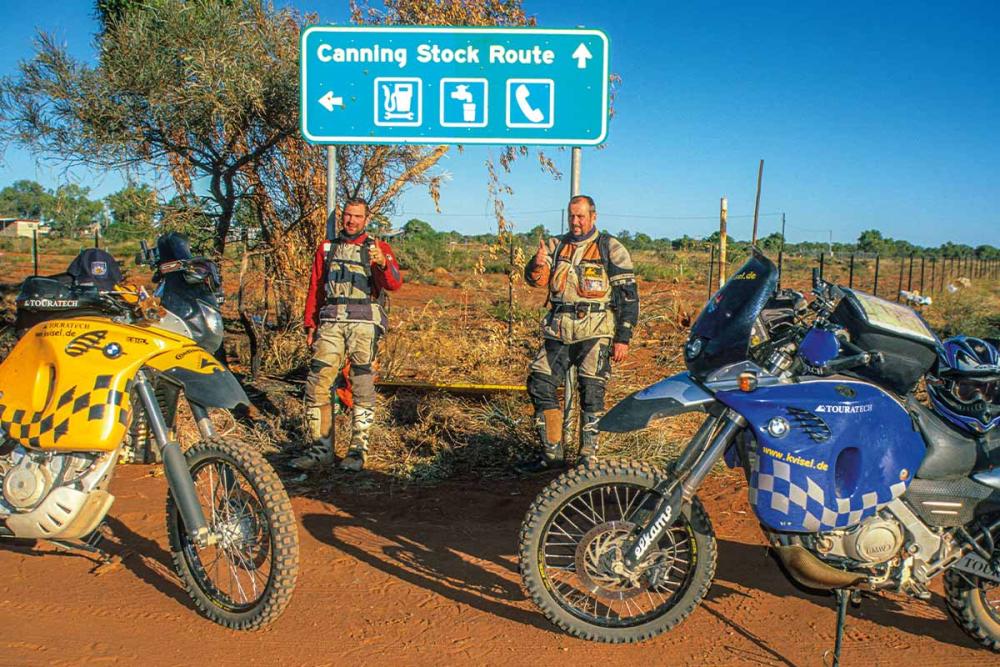
At the end: After two weeks, around 1,000 dunes had been conquered.
NORTHERN EUROPE: ABOUT LIFE OUT THERE
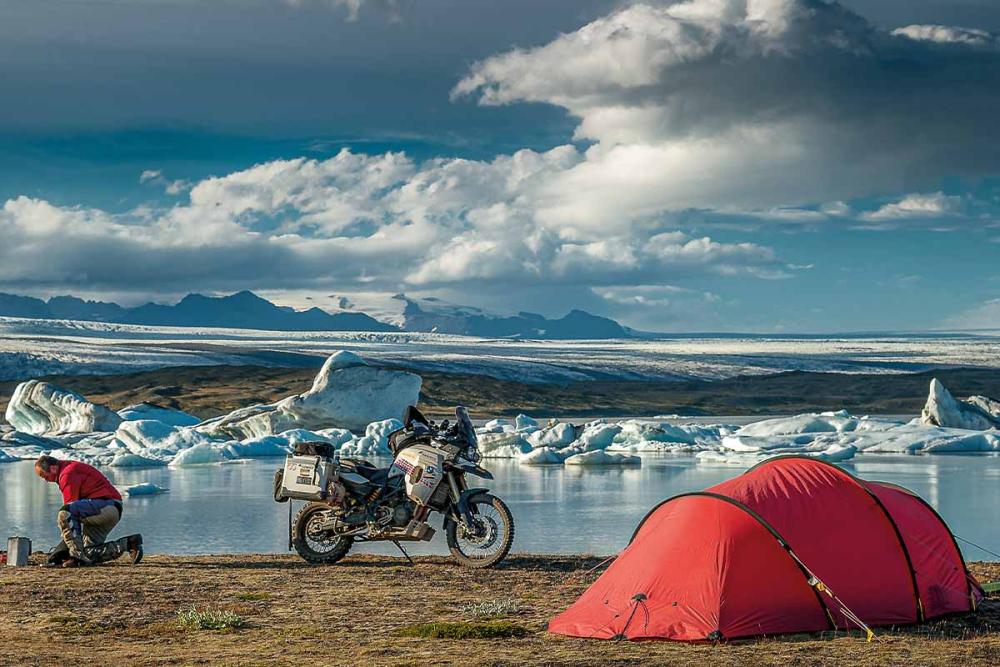
Icelandic idyll, a campsite right next to a glacial lake.
Whether Finland, Sweden, Norway or Iceland - Scandinavia has more magnificent landscapes than almost any other region in Europe. Over the years, the north has almost become my second home. I have been up there countless times, in Europe’s last wilderness. The endless forests of Sweden, the countless lakes of Finland or the rugged fjords of Norway: it's the uniqueness of nature that makes it so fascinating. And then there's Iceland. The island of fire and ice with its glaciers and volcanoes is on a different level. The tracks in the highlands are demanding, and if you want to drive through the barren interior for a few days, you have to be prepared. There are extremes that you always have to reckon with. Like the weather, for example, because even in summer there are always storm lows with ice and snow.
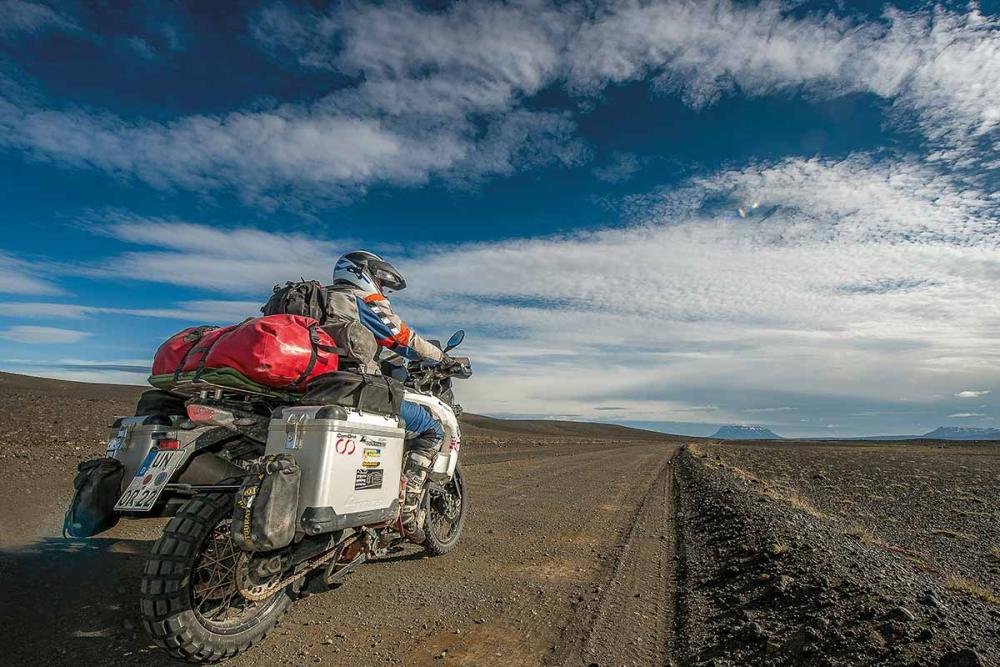
If you are travelling to Askia, you should be well prepared.
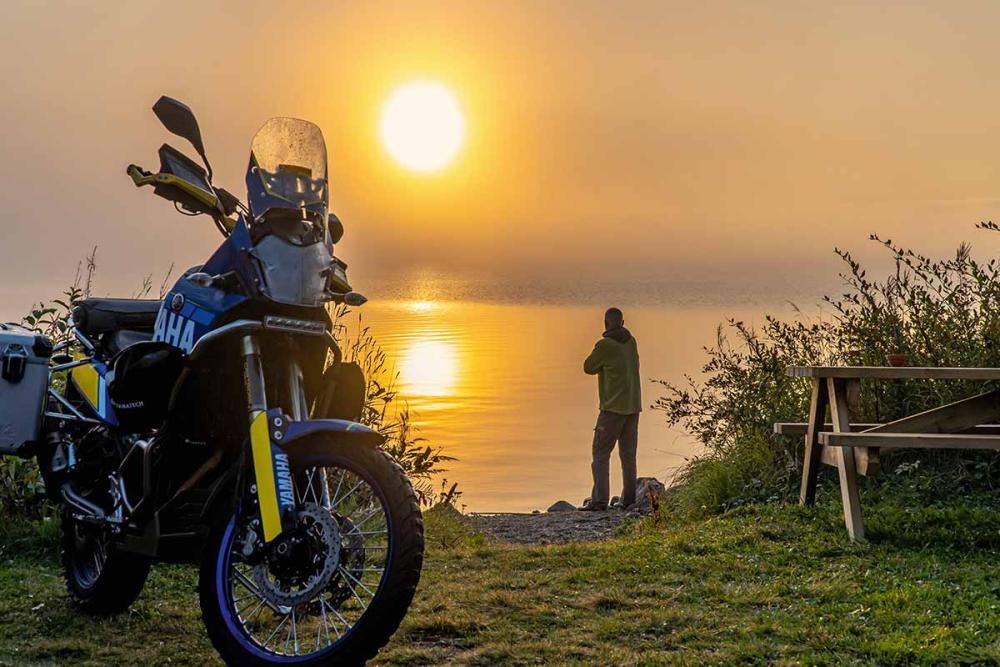
When it stops getting dark: Midnight sun in Lapland.
What do I love so much about the north? It's the freedom that can still be found there. Simply pitching your tent in the countryside in a beautiful spot for a night, made possible by the right of public access - for now. In view of the hustle and bustle of tourism in Iceland over the past few years, camping outside of campsites is hardly permitted any more. Unfortunately, this is a necessary measure, as the flow of visitors must be controlled in order to protect the magnificent natural environment. My insider tip: Autumn offers a very special spectacle in Lapland. "Ruska" is the name of the season when the fells start to "burn". It is the Scandinavian "Indian summer", when nature sets off fireworks just before winter. Motorcyclists who want to experience the "Ruska" should be rainproof and not shy away from cooler temperatures.
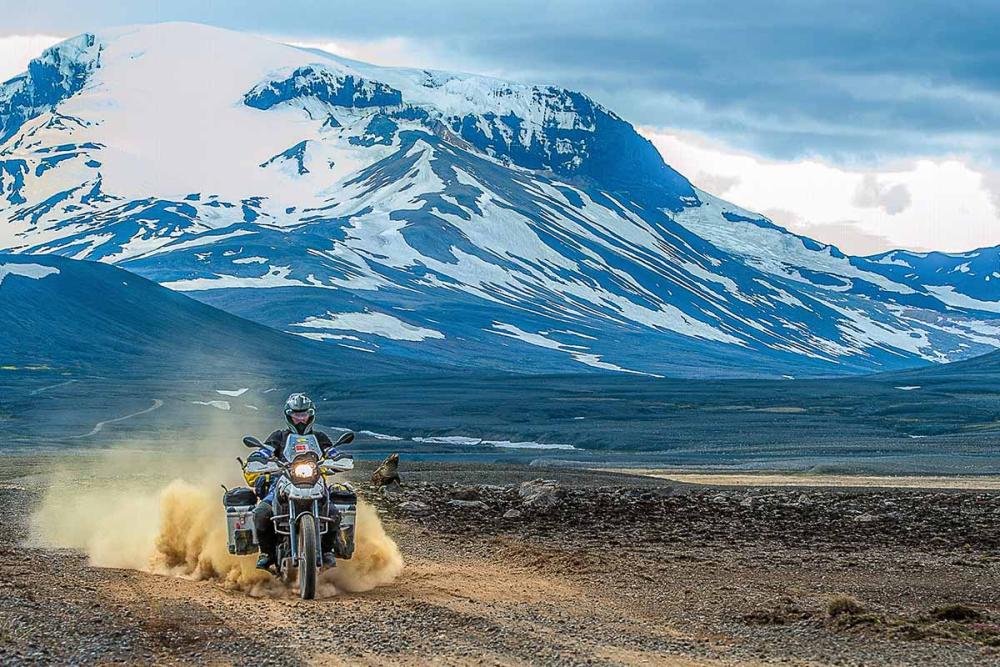
Slumbering for 10,000 years: The Snæfell volcano in the east of Iceland.
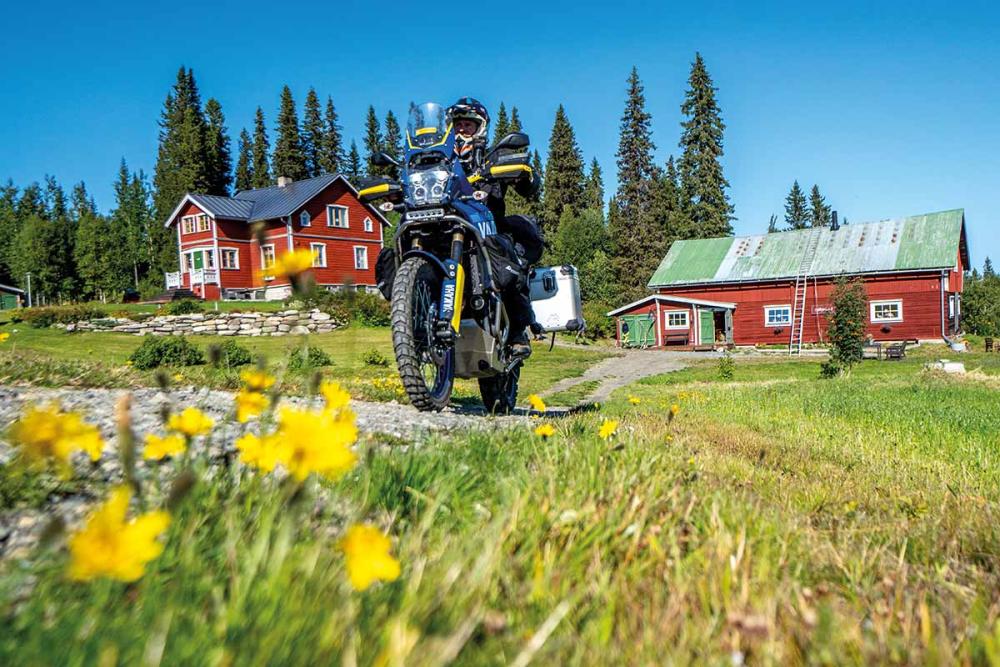
Red houses, blue sky, green forest: Sweden in picture-book format.
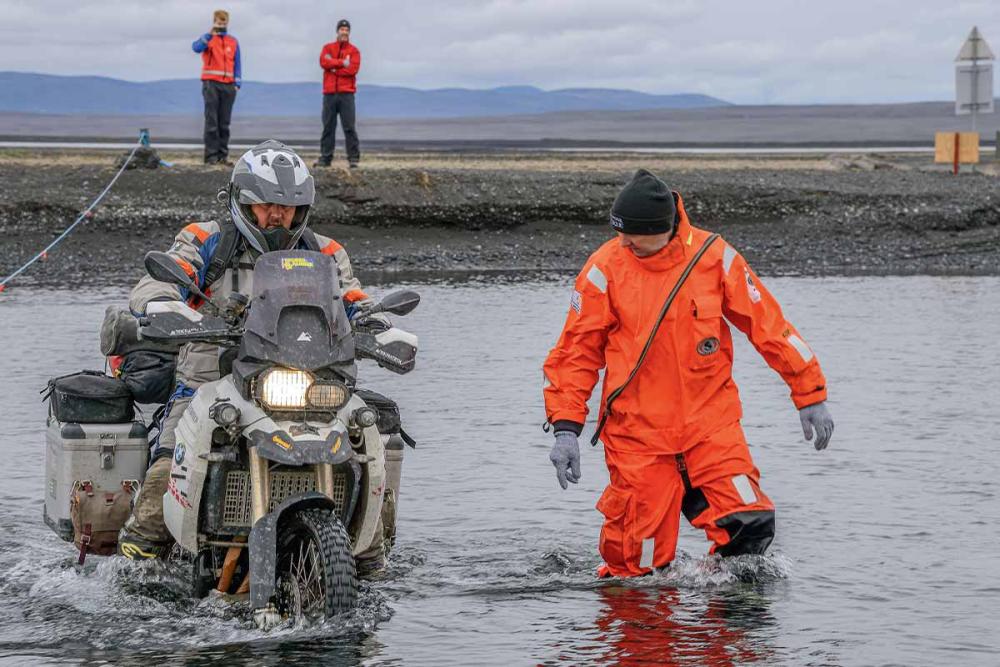
Icelandic rescue teams provide assistance with tricky river crossings.
SOUTH AMERICA: THE END OF THE WORLD
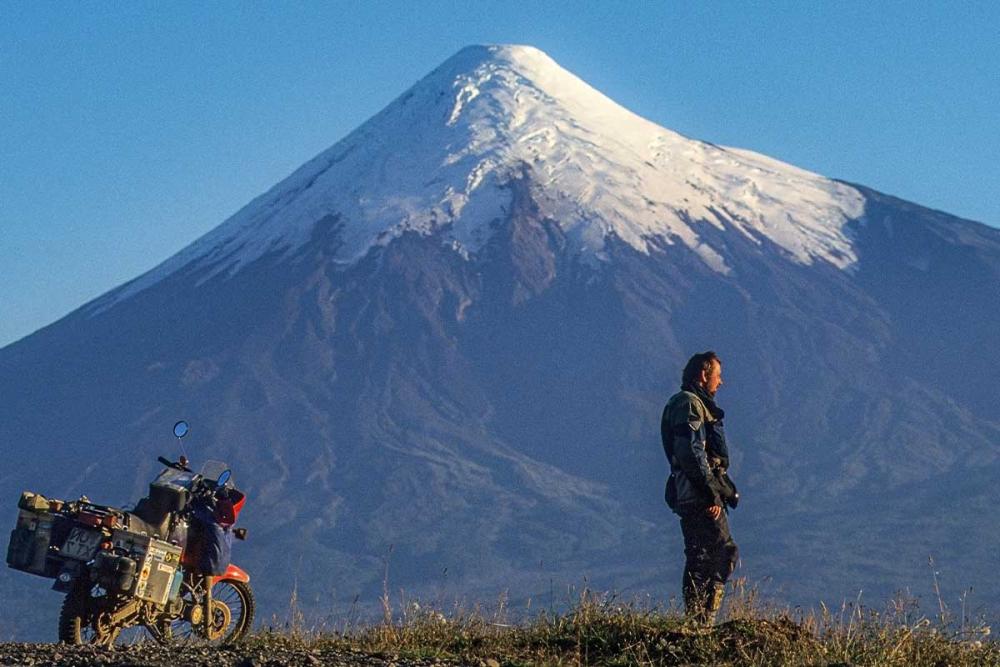
The Osorno is one of the most beautiful volcanoes in South America.
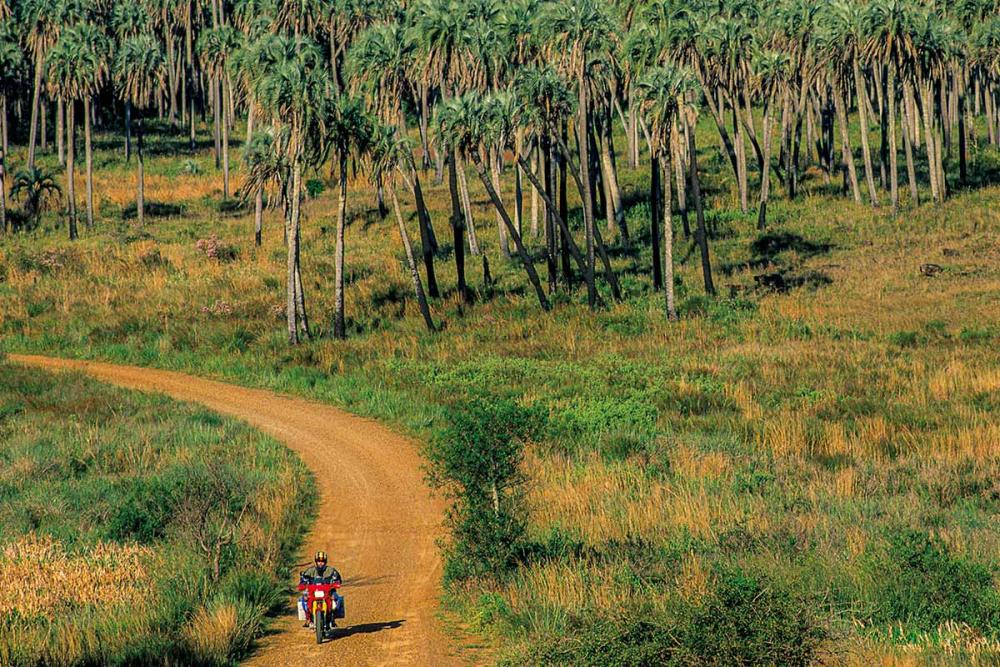
The climate in Brazil is slowly becoming tropical.
Even the names sound promising of adventure: Tierra del Fuego, Ruta 40, Fitz Roy or Perito Moreno. All these places had an exciting ring to them. I had almost half a year to travel to the end of the world, to Tierra del Fuego and to feel the eternal wind of Patagonia. The conditions for this trip were not ideal. My Ténére had already done more than 150,000 kilometres and was no longer 100 per cent reliable. But I had no choice; if I wanted to travel through South America on a motorbike, my old single-cylinder was the only option. My finances were running on an emergency programme, as my bank account had still not fully recovered from the two previous trips through Australia. The offer from Touratech came at just the right time. The first generation of ZEGA cases had not been on the market for long back in 1997 and the company was looking for someone to put the aluminium boxes through their paces. And so, the ZEGA cases accompanied me for 25,000 kilometres on the rough tracks at world’s end.
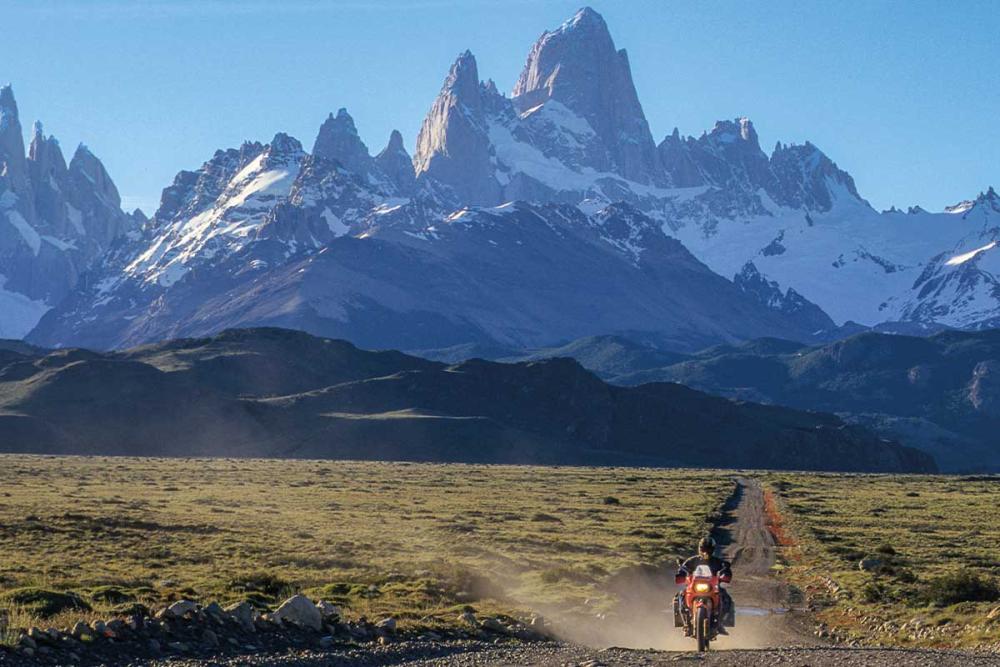
Back then an unpaved track: The route to the Fitz Roy massif.
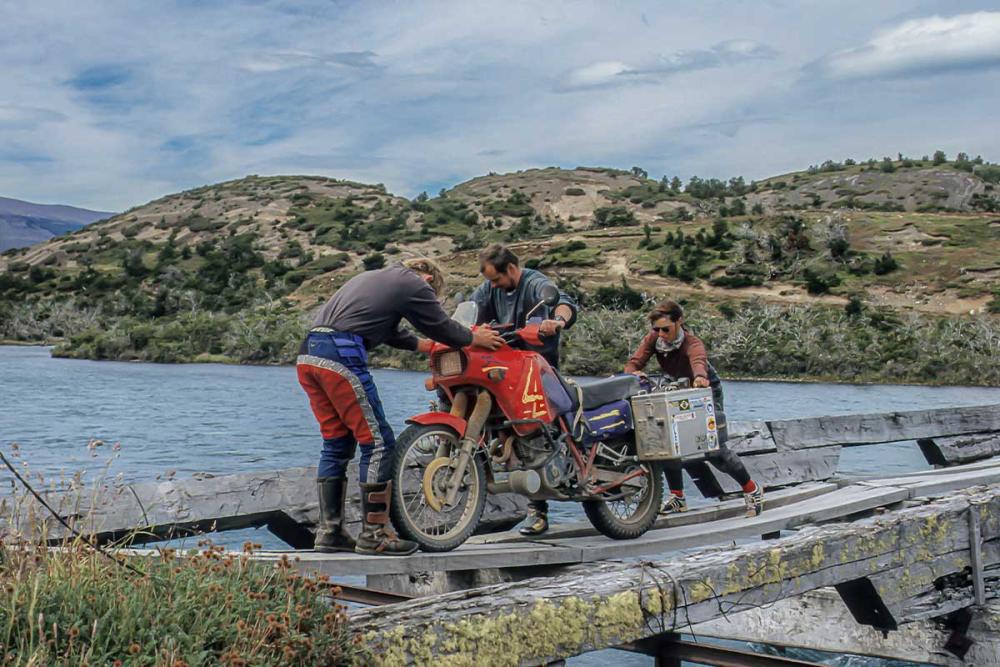
Crumbling bridge on the way to Torres del Paine National Park.

The Patagonia Express has been travelling through the steppe for almost 100 years.
On this tour, my XT 600 Ténéré couldn't hide the fact that it had already covered quite a few kilometres. At the end of the trip, the single was about to fall in two - the frame was completely broken and the main tube was done through. After tours of Scandinavia, the Icelandic highlands, Australia and New Zealand, South America was my 600's last big outing. She was entering her tenth year and had earned her retirement. After all, she had just under 180,000 kilometres on the clock at the end of this trip.
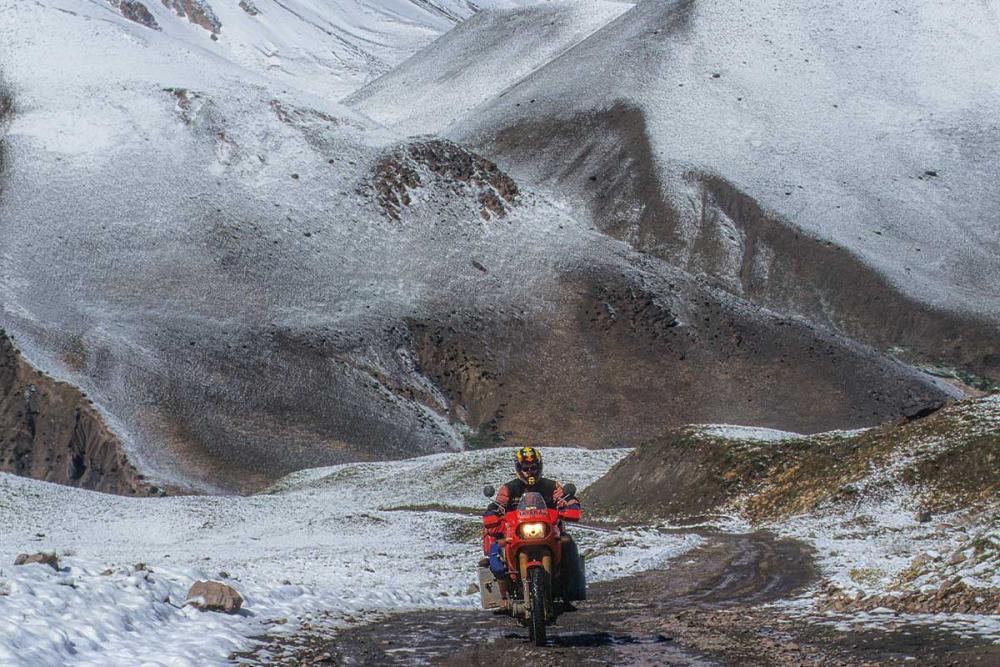
Even in summer, you still have to expect snow on Aconcagua.
CENTRAL ASIA / SIBERIA / MONGOLIA: EASTERN EXPERIENCE
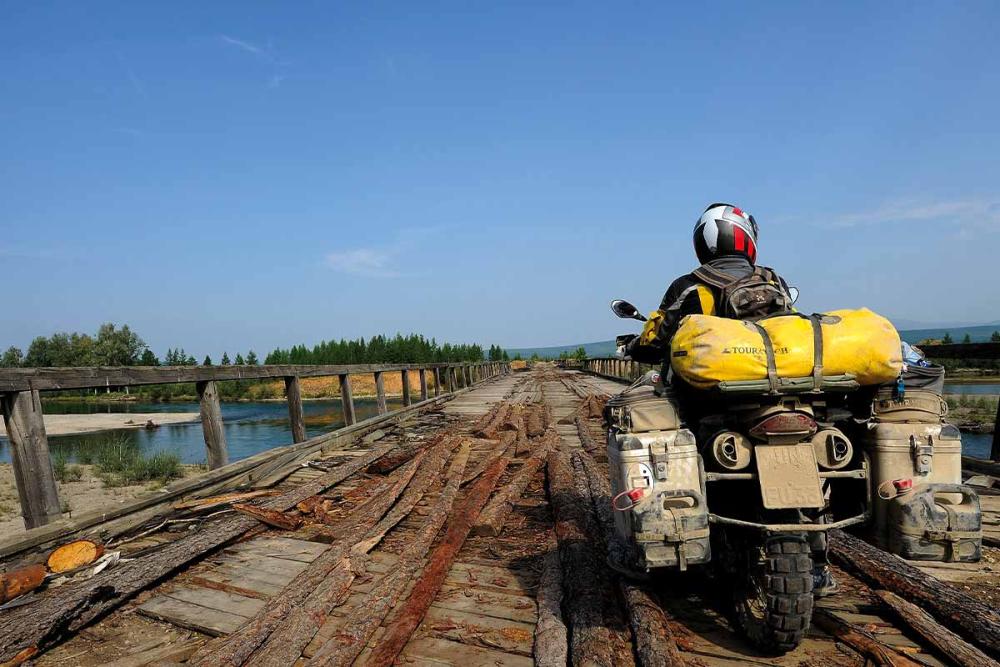
The bridges on the Road of Bones are in poor condition.
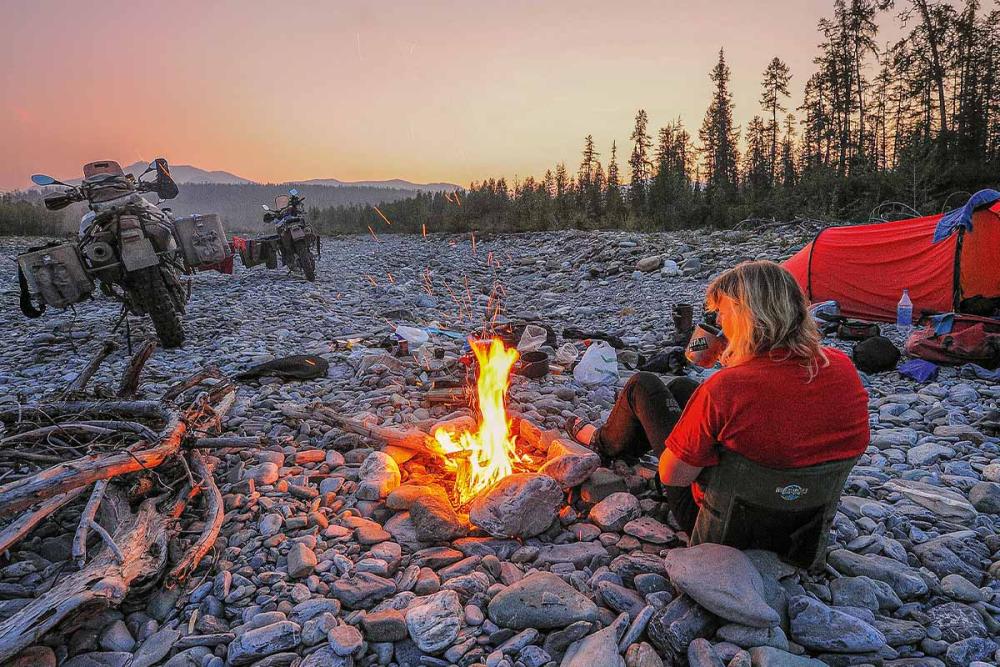
In eastern Siberia, a dry riverbed has to suffice as a campsite.
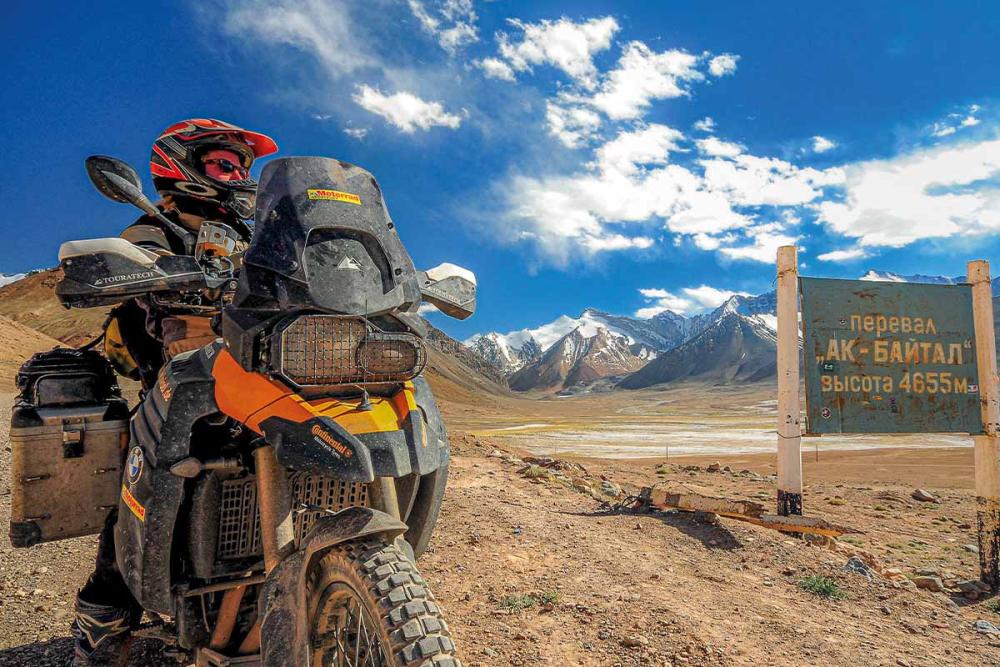
At 4655 metres, the Akbaital is the highest pass in the Pamirs.
It's the backyards of the world that I'm particularly interested in, and many of these areas can be found in Siberia, Mongolia and Central Asia. All these regions have a lot of these "untidy" landscapes. The endlessness of Siberia, the vastness of the Mongolian steppe, as well as the Silk Road, which runs through the whole of Central Asia, are magnificent. In addition, fascinating cities such as Khiwa, Bukhara or Samarkand and the overwhelming heights of the Pamir Mountains, whose highest pass reaches 4,655 metres above sea level. Claudia and I have travelled more than 90,000 kilometres on motorbikes beyond the Urals, with one trip taking us as far as Magadan at the eastern end of the Eurasian landmass. Among the many tracks was the "Road of Bones", the legendary route made famous by Ewan McGregor and Charley Boorman in their 2004 film "Long way round".
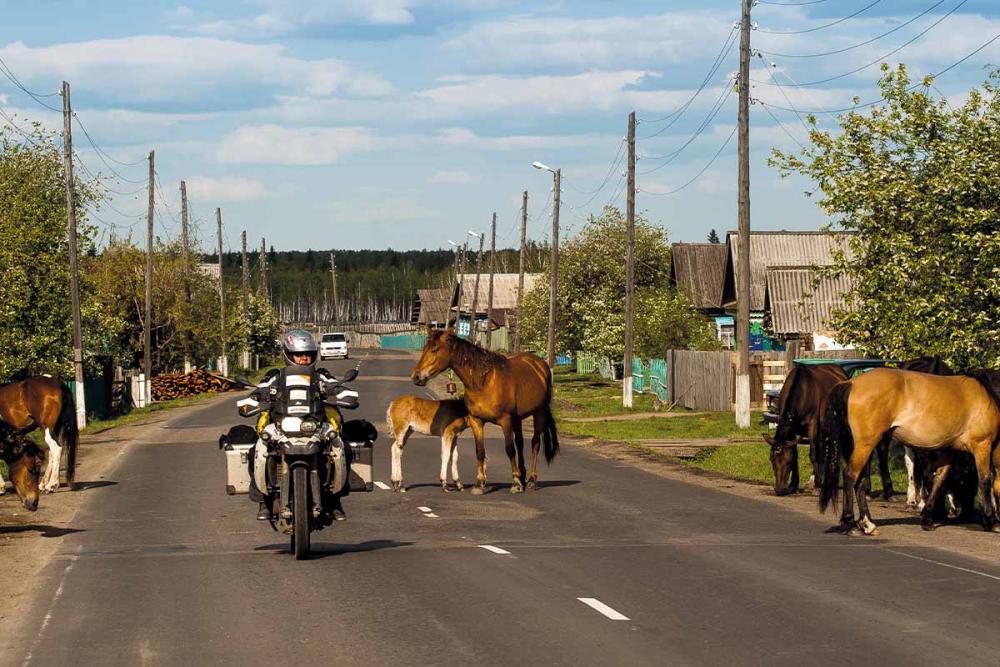
Four-legged horsepower on the Siberian Highway.
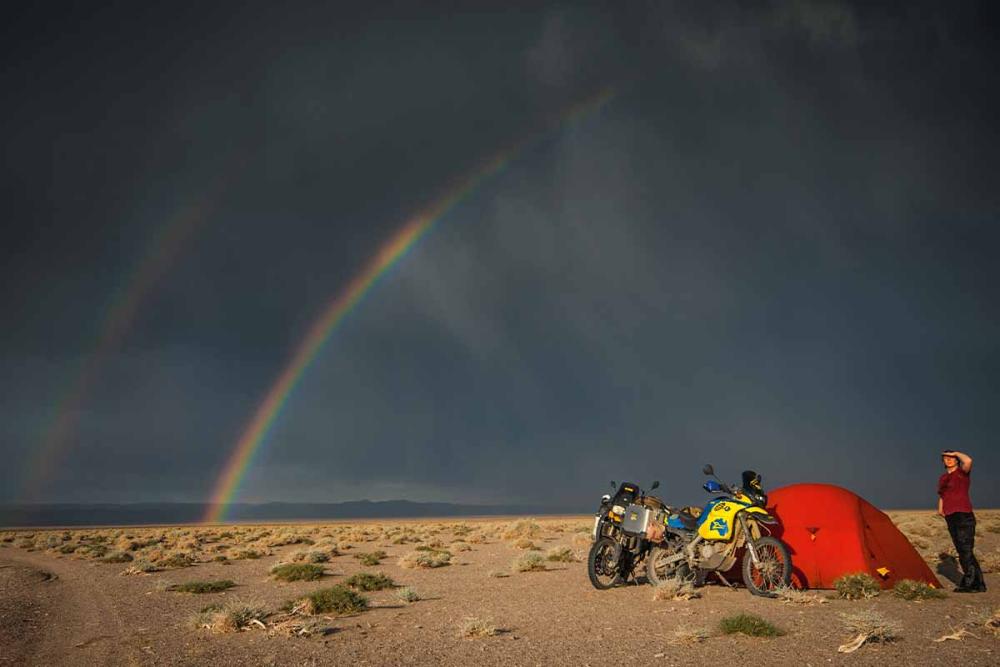
Dramatic thunderstorm atmosphere in the Gobi.
The regions in Siberia, Mongolia and Central Asia often place considerable demands on people and also on the technology. The quality of the petrol alone was always a challenge for the engine. Petrol with 91 octane was rarely available, 86 octane was available in the cities and in the countryside we were happy that the petrol in our tanks ignited at all. It was amazing how well the motorbikes handled the "bell soup". The BMWs, such as the F 650 GS, R 1150 GS or F 800 GS, which we rode eastwards, never complained about the bad petrol.
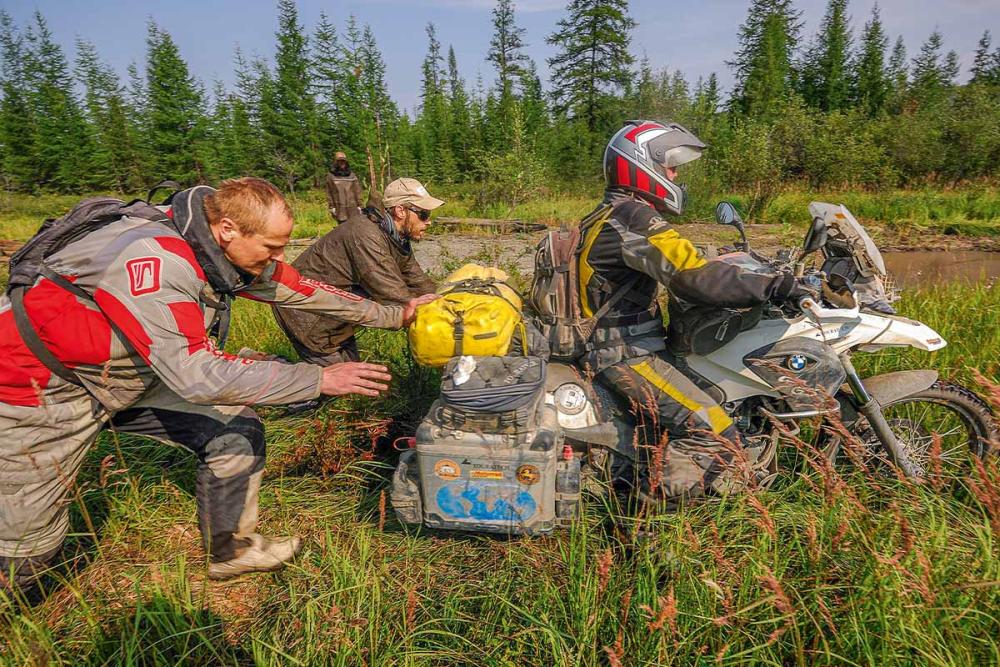
Teamwork: The Road of Bones is quite swampy in places.
WINTER TRAVEL: ANYONE CAN DO WARM WEATHER TRAVELLING
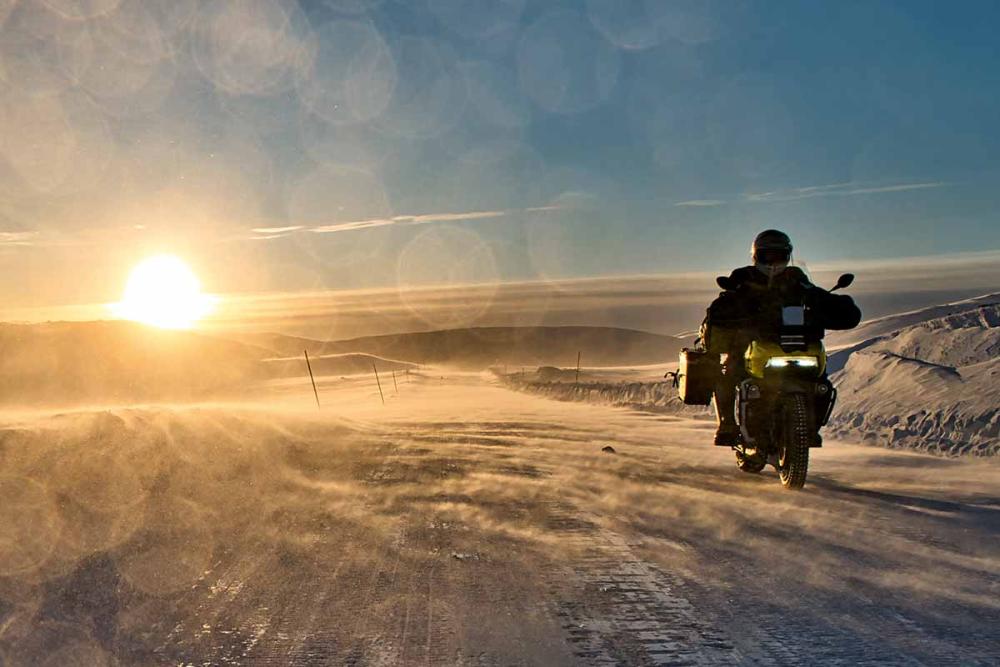
Stormy journey to the North Cape.
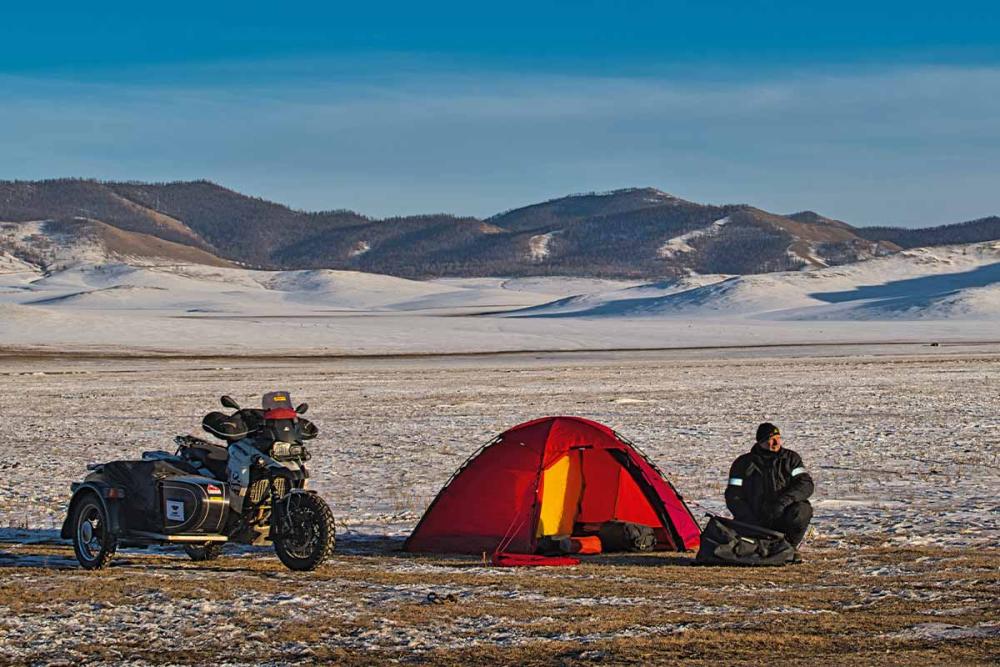
Winter camping in Mongolia.
When it comes to my winter tours, I'm often asked: "Why do you go to the places where it's really cold?". "Because it doesn't rain there!" is my - not entirely serious - answer. Travelling in sub-zero temperatures is a very special kind of motorcycling, but it requires very good preparation to ensure that such a frosty tour is an enjoyable and unforgettable experience. Extensive measures are required for travelling in sub-zero temperatures. An extra thick jumper under your jacket and long underpants are not enough. I have now completed six winter tours, four in Scandinavia, one of them to the North Cape, and twice I have travelled in extreme cold in Mongolia. My friend Rainer Krippner from Touratech Kassel was almost always with me. In Mongolia, we had to deal with temperatures of up to minus 35 degrees Celsius. A cold that makes gauntlets, thermal overalls and spikes indispensable equipment. Heated gloves or grips, as well as heated vests and trousers and additional thermal clothing extend the comfort zone when travelling in deep-freeze conditions. The “onion principle” has proved its worth when travelling, from functional underwear close to the body to thermal overalls. Rainer was travelling on the "Cold Contact" to the North Cape with the Compañero Rambler. Even at temperatures as low as minus 15 degrees Celsius, he didn't freeze in this suit. Another important point is the spikes. In this case, the more the better. For the tour to the North Cape, we screwed around 500 steel studs into the tread of each tyre.
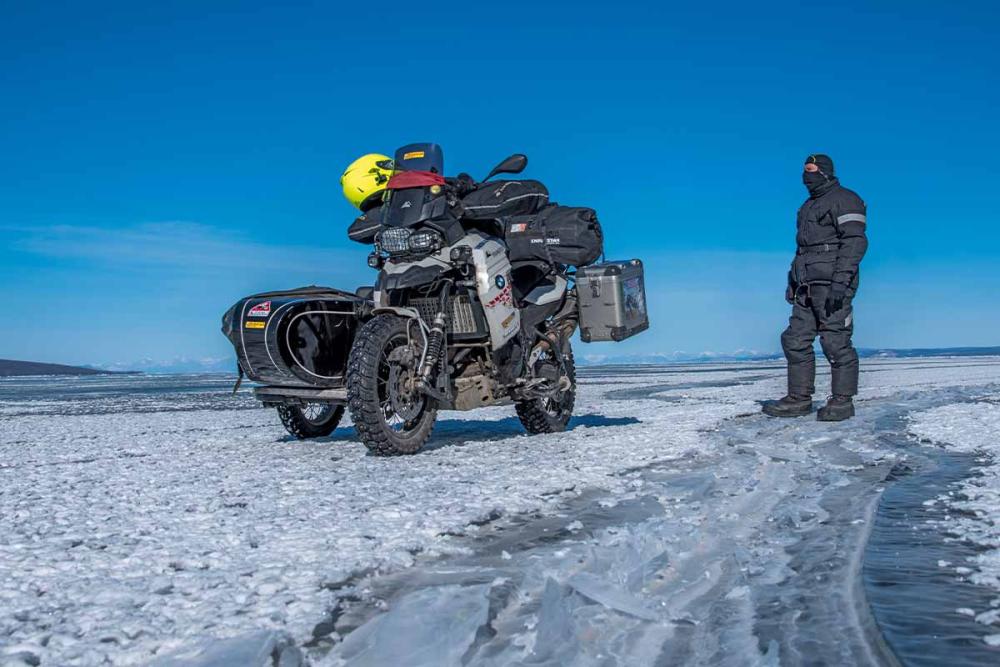
150 kilometres over the frozen Khovskol in Mongolia.
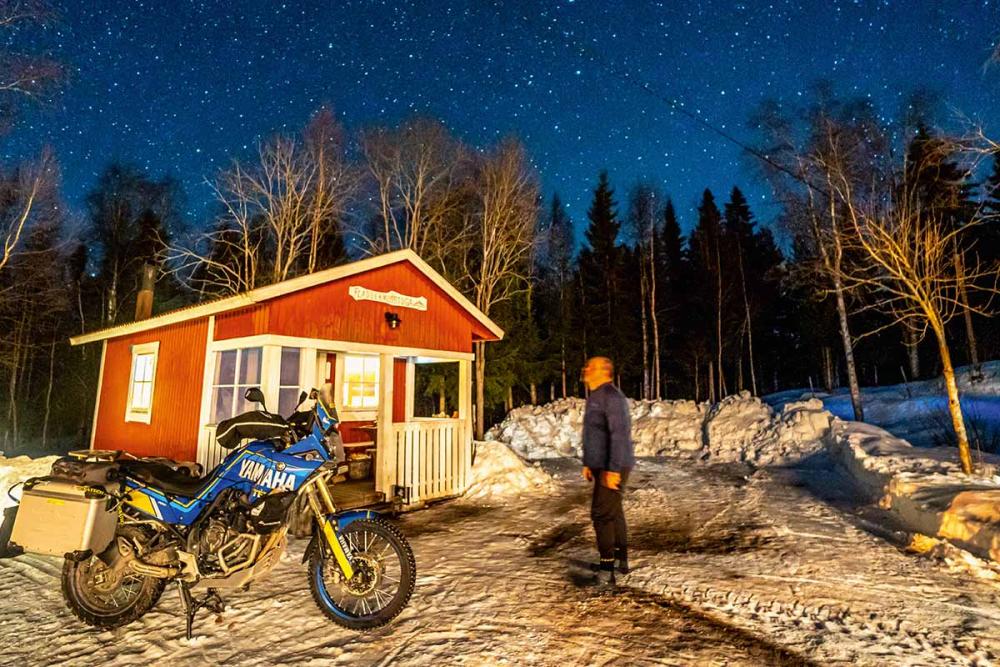
Always looking for the Northern Lights.
ANDREAS HÜLSMANN
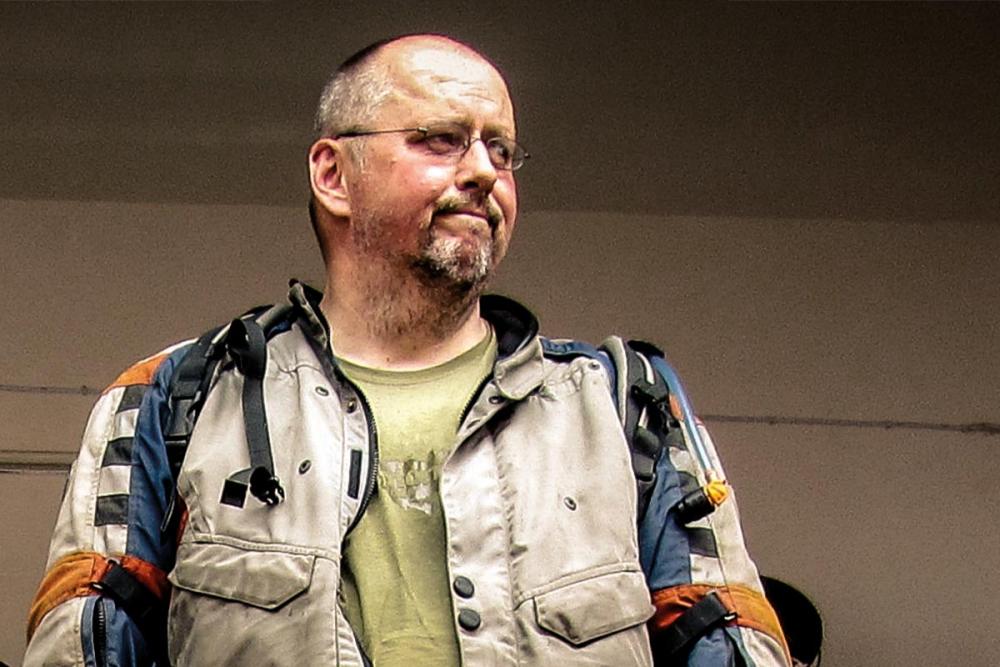
Born 2 June 1961 in Heeren Werve (eastern Ruhr region)
Trained profession: Mechanical engineer
Travelling on the motorbike since 1979, Journalist since 1988
Author for numerous magazines, Editor-in-Chief of Motorrad ABENTEUER magazine from 2006 to 2009 and 2014 to 2022
Current Motorcycle: Touratech-conversion of a Yamaha Ténéré 700








